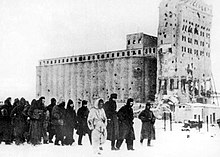Stalingrad shield

The Stalingrad shield was a German combat award planned by the German Wehrmacht during the Battle of Stalingrad , but not realized in World War II .
background
In October 1942 the High Command of the Army (OKH) was convinced that Stalingrad would be captured quickly . At the suggestion of Adolf Hitler , a Stalingrad shield should therefore also be created as a commemorative badge , corresponding to the Crimean shield and the Narvik shield . A corresponding order was issued to the 6th Army fighting in Stalingrad on October 26, 1942 . The suggestions for the design of this sleeve shield should be submitted to the OKH by November 25, 1942. The reaction of Friedrich Paulus , Commander in Chief of the 6th Army, to the corresponding telex from the OKH was sober:
“A sad chapter. We have barely taken half of the city and are running our heads on the rest. Given the current combat value of the troops, there is no telling whether we will achieve the goal we have set. Instead, they come to us with such insignificant, hasty stories like a Stalingrad sign. "
Design drawings
Despite his criticism, Paul had different design drawings made for the shield. In the synopsis for a planned but unrealized Stalingrad Book from March 1943, two of these shield designs, which were intended as “the Führer template”, are described:
“The shield, framed by an eagle, shows either the Stalingrad silo with the storm flag of the 71st Division in the middle of the rubble field, or the figure of an upright soldier who with his arms unites the spears pointed at his chest. The figure is placed in the ruins, oversized. The word «Stalingrad» is written across the sign. "
One of the drafts probably comes from the war correspondent Ernst Eigener , who was a member of the Propaganda Company 637 deployed in Stalingrad . The drawing was rejected as "too demoralizing". Eigen fell on November 20, 1942 in Stalingrad.
After the encirclement of Stalingrad and the later surrender of the 6th Army, the foundation of the shield was not pursued any further. The Stalingrad shield was neither produced nor awarded. There were also no trial mintings. The badges that appeared after 1945 as the Stalingrad shield are, without exception, falsifications from the post-war period.
Others
The Stalingrad shield itself must not be confused with the so-called "Stalingrad Cross", which was the division badge of the 44th Infantry Division "Hoch- und Deutschmeister" , and the so-called "Stalingrad Medal", a commemorative medal of the motorcyclist battalion 64, the was subordinate to the 14th Panzer Division at the time.
See also
literature
- Kurt-G. Klietmann : Awards of the German Reich 1936–1945. A documentation of civil and military badges of merit and honor. 11th edition. Motorbuch-Verlag, Stuttgart 2004, ISBN 3-87943-689-4 , pp. 98f.
- Klaus D. Patzwall : Madness and Reality - the Stalingrad Shield. In: Militaria. 34th vol., No. 3, 2004, ISSN 0724-3529 , pp. 103-105.
Individual evidence
- ↑ a b Martin Broszat , Norbert Frei , Institute for Contemporary History (ed.): Ploetz. The Third Empire. Origins, events, effects. Ploetz, Freiburg 1983, ISBN 3-87640-083-X , p. 126.
- ↑ Wilhelm Adam : The difficult decision. Verlag der Nation, Berlin (East) 1965, pp. 118f.
- ↑ Stalingrad's heroism. Exposé v. March 13, 1943. BA Potsdam, WF-01/2153, Bl. 230ff .; printed in: Jens Ebert (Ed.): Stalingrad. A German legend. (= Rororo 13121 rororo current ). Rowohlt, Reinbek bei Hamburg 1992, ISBN 3-499-13121-8 , pp. 40-43.
- ^ Will Fowler: Stalingrad. The Vital 7 Days. Spellmount, Staplehurst 2005, ISBN 1-86227-278-6 , p. 74.